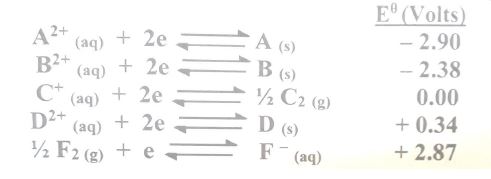 Get premium membership
Get premium membership and access revision papers with marking schemes, video lessons and live classes.
Use standard electrode potentials for elements A, B, C, D and F given below to answer the questions that follow. The letters do not represent the actual symbols of the elements.

(i) Which element is likely to be hydrogen? Give a reason for your answer.
(ii) What is the# E^θ# value of the strongest reducing agent?
(iii) In the space provided, draw a labelled diagram of the electrochemical cell that would be obtained when half-cells of elements B and D are combined.
(iv) Calculate the# E^θ# value of the electrochemical cell constructed in (iii) above.
(b) During the electrolysis of aqueous copper (II) sulphate using copper electrodes, a current of 0.2 amperes was passed through the cell for 5 hours.
(i) Write an ionic equation for the reaction that took place at the anode.
(ii) Determine the change in mass of the anode which occurred as a result of the
electrolysis process. (Cu=63.5, 1 Faraday=96,500 coulombs.)